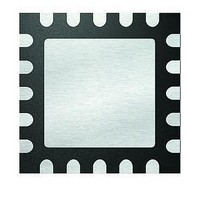MCP4461T-502E/ML Microchip Technology, MCP4461T-502E/ML Datasheet - Page 54

MCP4461T-502E/ML
Manufacturer Part Number
MCP4461T-502E/ML
Description
IC DGTL POT 257TAPS 5K 20QFN
Manufacturer
Microchip Technology
Datasheet
1.MCP4441-103EML.pdf
(100 pages)
Specifications of MCP4461T-502E/ML
Package / Case
20-VFQFN Exposed Pad
Temperature Coefficient
150 ppm/°C Typical
Taps
257
Resistance (ohms)
5K
Number Of Circuits
4
Memory Type
Non-Volatile
Interface
I²C, 2-Wire Serial
Voltage - Supply
2.7 V ~ 5.5 V
Operating Temperature
-40°C ~ 125°C
Mounting Type
Surface Mount
Number Of Pots
Quad
Taps Per Pot
257
Resistance
5 KOhms
Wiper Memory
Non Volatile
Buffered Wiper
Buffered
Digital Interface
I2C
Operating Supply Voltage
2.7 V to 5.5 V
Supply Current
600 uA
Maximum Operating Temperature
+ 125 C
Minimum Operating Temperature
- 40 C
Description/function
Quad I2C Digital POT with Nonvolatile Memory
Mounting Style
SMD/SMT
Supply Voltage (max)
5.5 V
Supply Voltage (min)
2.7 V
Lead Free Status / RoHS Status
Lead free / RoHS Compliant
MCP444X/446X
6.2
The MCP44XX’s I
Philips I
modules features:
• 7-bit slave addressing
• Supports three clock rate modes:
• Support Multi-Master Applications
• General call addressing
• Internal weak pull-ups on interface signals
The I
The Philips I
types, field lengths, timings, etc. of a frame. The frame
content defines the behavior of the device. The frame
content for the MCP44XX is defined in Section 7.0.
6.2.1
Figure 6-8
clock is generated by the master. The following defini-
tions are used for the bit states:
• Start bit (S)
• Data bit
• Acknowledge (A) bit (driven low) /
• Repeated Start bit (Sr)
• Stop bit (P)
6.2.1.1
The Start bit (see
a data transfer sequence. The Start bit is defined as the
SDA signal falling when the SCL signal is “High”.
FIGURE 6-2:
6.2.1.2
The SDA signal may change state while the SCL signal
is Low. While the SCL signal is High, the SDA signal
MUST be stable (see
FIGURE 6-3:
DS22265A-page 54
SDA
SCL
SDA
SCL
- Standard mode, clock rates up to 100 kHz
- Fast mode, clock rates up to 400 kHz
- High-speed mode (HS mode), clock rates up
No Acknowledge (A) bit (not driven low)
to 3.4 MHz
2
C 10-bit addressing mode is not supported.
2
C specification. The following lists some of the
I
2
S
shows the I
C Operation
I
2
C BIT STATES AND SEQUENCE
Start Bit
Data Bit
2
C specification only defines the field
Figure
2
C module is compatible with the
Figure
2
Start Bit.
Data Bit.
C transfer sequence. The serial
6-2) indicates the beginning of
1st Bit
6-5).
Data Bit
1st Bit
2nd Bit
2nd Bit
6.2.1.3
The A bit (see
the receiving device to the transmitting device.
Depending on the context of the transfer sequence, the
A bit may indicate different things. Typically the Slave
device will supply an A response after the Start bit and
8 “data” bits have been received. an A bit has the SDA
signal low.
FIGURE 6-4:
Not A (A) Response
The A bit has the SDA signal high.
some of the conditions where the Slave Device will
issue a Not A (A).
If an error condition occurs (such as an A instead of A),
then an START bit must be issued to reset the
command state machine.
TABLE 6-1:
General Call
Slave Address
valid
Slave Address
not valid
Device Mem-
ory Address
and specified
command
(AD3:AD0 and
C1:C0) are an
invalid combi-
nation
Communica-
tion during
EEPROM write
cycle
Bus Collision
SDA
SCL
Event
Acknowledge (A) Bit
Figure
8
D0
MCP45XX/MCP46XX A / A
RESPONSES
Acknowledge
Response
6-4) is typically a response from
Acknowledge Waveform.
N.A.
© 2010 Microchip Technology Inc.
Bit
A
A
A
A
A
Only if GCEN bit is
set
After device has
received address
and command
After device has
received address
and command,
and valid condi-
tions for EEPROM
write
I
Resets, or a “Don’t
Care” if the colli-
sion occurs on the
Master’s “Start bit”
2
C Module
Table 6-1
Comment
9
A
shows















